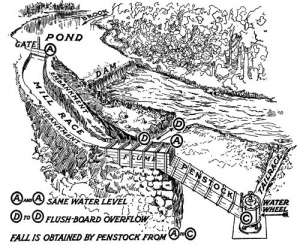Frederick Irving Anderson. Electricity for the farm
New York, 1915
This book is designed primarily to give the farmer a practical working knowledge of electricity for use as light, heat, and power on the farm. The electric generator, the dynamo, is explained in detail; and there are chapters on electric transmission and house-wiring, by which the farm mechanic is enabled to install his own plant without the aid and expense of an expert.
With mode appliances, within the means of the average farmer, the generation of electricity, with its unique conveniences, becomes automatic, provided some dependable source of power is to be had — such as a water wheel, gasoline (or other form of inteal combustion) engine, or the ordinary windmill. The water wheel is the ideal prime mover for the dynamo in isolated plants. Since water-power is running to waste on tens of thousands of our farms throughout the country, several chapters are devoted to this phase of the subject: these include descriptions and working diagrams of weirs and other simple devices for measuring the flow of streams; there are tables and formulas by which any one, with a knowledge of simple arithmetic, may determine the power to be had from falling water under given conditions; and in addition, there are diagrams showing in general the method of construction of dams, bulkheads, races, flumes, etc. , from materials usually to be found on a farm.
New York, 1915
This book is designed primarily to give the farmer a practical working knowledge of electricity for use as light, heat, and power on the farm. The electric generator, the dynamo, is explained in detail; and there are chapters on electric transmission and house-wiring, by which the farm mechanic is enabled to install his own plant without the aid and expense of an expert.
With mode appliances, within the means of the average farmer, the generation of electricity, with its unique conveniences, becomes automatic, provided some dependable source of power is to be had — such as a water wheel, gasoline (or other form of inteal combustion) engine, or the ordinary windmill. The water wheel is the ideal prime mover for the dynamo in isolated plants. Since water-power is running to waste on tens of thousands of our farms throughout the country, several chapters are devoted to this phase of the subject: these include descriptions and working diagrams of weirs and other simple devices for measuring the flow of streams; there are tables and formulas by which any one, with a knowledge of simple arithmetic, may determine the power to be had from falling water under given conditions; and in addition, there are diagrams showing in general the method of construction of dams, bulkheads, races, flumes, etc. , from materials usually to be found on a farm.

